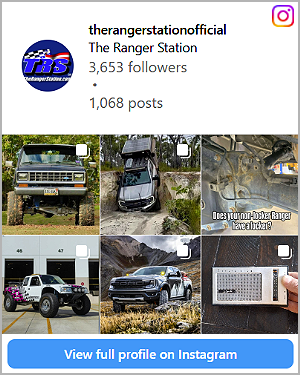- Joined
- Jan 2, 2001
- Messages
- 8,001
- Points
- 5,101
- Age
- 41
- City
- Lancaster, Ohio
- Vehicle Year
- 2016
- Engine
- Transmission
- Automatic
- Total Lift
- 5"
- Tire Size
- 35"
Originally compiled by 'rusty ol ranger'
General 2.9L Info
Years Produced- 1986-1992
Engine Displacement (Cubic Inches)- 177
Fuel System- MPFI (Multiport Electronic Fuel Injection)
Cylinders-6
Arrangment of Cylinders- "V" Shape
BorexStroke- 3.66x2.83
Horsepower- 140@4600RPM
Torque- 170@2600RPM
Engine Family- "Colonge"
Oil Pressure- 20PSI@Warm Idle 55PSI@2000RPM
Spark Plug Gap- .44
Ignition Timing- 12* BTDC
Fireing Order- 1-4-2-5-3-6
Distributor Rotation- Clockwise
Cylinder Location-
Front of Vehicle
4 1
5 2
6 3
Oil Capacity- 5.0QT W/Filter Change
4.0QT W/O Filter Change
Cooling System Capacity (Quarts)- W/AC- 7.2
W/O AC 7.8
Known Issues-
Cylinder Head Cracking Caused usually by overheating the Engine, most common symptoms are clean spark plugs, white exhaust smoke when warm, low compression on one or more cylinders, and "snot" on the oil cap or dipstick. Sometimes the "Snot" can just be condensation, so make sure the Engine is warm before checking.
Best Course of Action Park the truck, Drain the oil, pull the heads, and have them magnafluxed to make sure you have a crack, if you do DO NOT RUN THE TRUCK, coolant in the oil toasts crankshaft bearings, requireing a total rebuild. If the truck isnt run to long than you can probely get away with just heads.
Ticking Lifters Sometimes mistaken for ticking fuel injectors. This condition isn't a cause for alarm unless it does it very loudly or after long freeway trips., if it does have the oil pressure checked, it could be low.
Valve Cover Gaskets Other than making the Engine look nasty and smell nasty, these pose no danger. Some claims have been made of the motor catching fire because so much oil leaked on the exhaust, but this is rare. Replace with Fel Pro "Rubber" or Fel Pro "Blue" and leaks should be taken care of.
History of the 2.9L
Introduced in Late 85 on the 86 Models, the 2.9L was a larger, more powerful, fuel injected replacement for the old 2.8L Engine. It was born into the "Colonge" family of Engines which include the 2.6L Mazda, the 2.8L Ford, and the 4.0L FordMazda Engines. The 2.9 never saw duty in anything other than the Ranger and BII. Aerostars went right to the 3.0 from the 2.8 and Explorers used the 4.0 when introduced in 91. The 2.9 Co-existed alongside the 3.0, the Engine which replaced it, untill 1992, when Ford introduced a "More Refined" Ranger, the 2.9 wasnt a refined engine like the 3.0 "Vulcan". It was rough, noisy, and crude. The 3.0 was none of these things so it replaced the 2.9 in 93, even with its meager low end torque (compared to the 2.9) it still is the only Small V6 offered in the Ranger, next to the Big Brother 4.0. The 4.0 is related to the 2.9L however, so in a way it still lives on. The 3.0 is in NO WAY related to the 2.9L V6 Engine.
Links to Threads of Interest
Towing with a 2.9L
What Spark plugs are right?
Classic case of Dead Ignition Module (TFI) syndrome
Dos and donts of building a 2.9L for performance
NOTE
This FAQ is work in progress. As the Forum grows and more info is added to the board, the FAQ will grow with it. Then, we'll have a very large weath of knowledge and problem solving abilty about the 2.9L V6 Engine, all in one place. Also, any problems with links drop me a PM. Thank you
General 2.9L Info
Years Produced- 1986-1992
Engine Displacement (Cubic Inches)- 177
Fuel System- MPFI (Multiport Electronic Fuel Injection)
Cylinders-6
Arrangment of Cylinders- "V" Shape
BorexStroke- 3.66x2.83
Horsepower- 140@4600RPM
Torque- 170@2600RPM
Engine Family- "Colonge"
Oil Pressure- 20PSI@Warm Idle 55PSI@2000RPM
Spark Plug Gap- .44
Ignition Timing- 12* BTDC
Fireing Order- 1-4-2-5-3-6
Distributor Rotation- Clockwise
Cylinder Location-
Front of Vehicle
4 1
5 2
6 3
Oil Capacity- 5.0QT W/Filter Change
4.0QT W/O Filter Change
Cooling System Capacity (Quarts)- W/AC- 7.2
W/O AC 7.8
Known Issues-
Cylinder Head Cracking Caused usually by overheating the Engine, most common symptoms are clean spark plugs, white exhaust smoke when warm, low compression on one or more cylinders, and "snot" on the oil cap or dipstick. Sometimes the "Snot" can just be condensation, so make sure the Engine is warm before checking.
Best Course of Action Park the truck, Drain the oil, pull the heads, and have them magnafluxed to make sure you have a crack, if you do DO NOT RUN THE TRUCK, coolant in the oil toasts crankshaft bearings, requireing a total rebuild. If the truck isnt run to long than you can probely get away with just heads.
Ticking Lifters Sometimes mistaken for ticking fuel injectors. This condition isn't a cause for alarm unless it does it very loudly or after long freeway trips., if it does have the oil pressure checked, it could be low.
Valve Cover Gaskets Other than making the Engine look nasty and smell nasty, these pose no danger. Some claims have been made of the motor catching fire because so much oil leaked on the exhaust, but this is rare. Replace with Fel Pro "Rubber" or Fel Pro "Blue" and leaks should be taken care of.
History of the 2.9L
Introduced in Late 85 on the 86 Models, the 2.9L was a larger, more powerful, fuel injected replacement for the old 2.8L Engine. It was born into the "Colonge" family of Engines which include the 2.6L Mazda, the 2.8L Ford, and the 4.0L FordMazda Engines. The 2.9 never saw duty in anything other than the Ranger and BII. Aerostars went right to the 3.0 from the 2.8 and Explorers used the 4.0 when introduced in 91. The 2.9 Co-existed alongside the 3.0, the Engine which replaced it, untill 1992, when Ford introduced a "More Refined" Ranger, the 2.9 wasnt a refined engine like the 3.0 "Vulcan". It was rough, noisy, and crude. The 3.0 was none of these things so it replaced the 2.9 in 93, even with its meager low end torque (compared to the 2.9) it still is the only Small V6 offered in the Ranger, next to the Big Brother 4.0. The 4.0 is related to the 2.9L however, so in a way it still lives on. The 3.0 is in NO WAY related to the 2.9L V6 Engine.
Links to Threads of Interest
Towing with a 2.9L
What Spark plugs are right?
Classic case of Dead Ignition Module (TFI) syndrome
Dos and donts of building a 2.9L for performance
NOTE
This FAQ is work in progress. As the Forum grows and more info is added to the board, the FAQ will grow with it. Then, we'll have a very large weath of knowledge and problem solving abilty about the 2.9L V6 Engine, all in one place. Also, any problems with links drop me a PM. Thank you
Last edited by a moderator:












